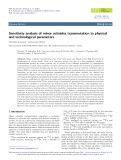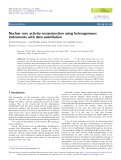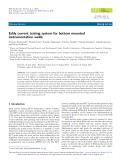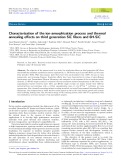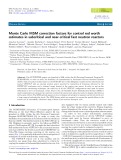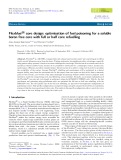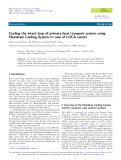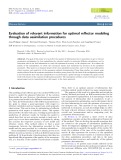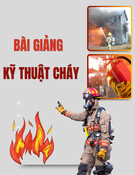
REGULAR ARTICLE
Heterogeneous world model and collaborative scenarios
of transition to globally sustainable nuclear energy systems
Vladimir Kuznetsov
*
and Galina Fesenko
International Atomic Energy Agency, Vienna International Centre, PO Box 100, 1400 Vienna, Austria
Received: 11 May 2015 / Received in final form: 2 July 2015 / Accepted: 20 July 2015
Published online: 27 November 2015
Abstract. The International Atomic Energy Agency’s International Project on Innovative Nuclear Reactors and
Fuel Cycles (INPRO) is to help ensure that nuclear energy is available to contribute to meeting global energy
needs of the 21st century in a sustainable manner. The INPRO task titled “Global scenarios”is to develop global
and regional nuclear energy scenarios that lead to a global vision of sustainable nuclear energy in the 21st century.
Results of multiple studies show that the criteria for developing sustainable nuclear energy cannot be met without
innovations in reactor and nuclear fuel cycle technologies. Combining different reactor types and associated fuel
chains creates a multiplicity of nuclear energy system arrangements potentially contributing to global
sustainability of nuclear energy. In this, cooperation among countries having different policy regarding fuel cycle
back end would be essential to bring sustainability benefits from innovations in technology to all interested users.
INPRO has developed heterogeneous global model to capture countries’different policies regarding the back end
of the nuclear fuel cycle in regional and global scenarios of nuclear energy evolution and applied in a number of
studies performed by participants of the project. This paper will highlight the model and major conclusions
obtained in the studies.
1 Introduction
The International Atomic Energy Agency’s (IAEA’s)
International Project on Innovative Nuclear Reactors
and Fuel Cycles (INPRO) has the objective of helping to
ensure that nuclear energy is available to contribute to
meeting global energy needs of the 21st century in a
sustainable manner. The INPRO task titled “Global
scenarios”has the objective to develop, based on scientific
and technical analysis, global and regional nuclear energy
scenarios that lead to a global vision of sustainable nuclear
energy in the 21st century [1–5].
Existing nuclear energy systems, which are almost
entirely based on thermal reactors operating in a once-
through cycle, will continue to be the main contributor to
nuclear energy production for at least several more decades.
However, results of multiple national and international
studies show that the criteria for developing sustainable
nuclear energy cannot be achieved without major innova-
tions in reactor and nuclear fuel cycle technologies.
New reactors, nuclear fuels and fuel cycle technologies are
under development and demonstration worldwide. Combin-
ing different reactor types and associated fuel chains creates a
multiplicity of nuclear energy system arrangements poten-
tially contributing to global sustainability of nuclear energy.
In this, cooperation among countries having different policy
regarding fuel cycle back end would be essential to bring
sustainability benefits from innovations in technology to all
interested users. It is becoming increasingly clear that
national strategies will have to be harmonized with regional
and global nuclear power architectures to make national
nuclear energy systems more sustainable.
INPRO is a part of the integrated services of the IAEA
provided to Member States considering initial development
or expansion of nuclear energy programmes. To provide
such countries with better understanding of the options
available to achieve sustainable nuclear energy, INPRO has
developed an internationally verified analytical framework
for assessing transition scenarios to future sustainable
nuclear energy systems (hereafter, the framework) and
applied in a number of studies performed by participants of
the project.
The economic studies carried out by INPRO have shown
that investments in Research, Design & Demonstration
(RD&D) for innovative technologies, such as fast reactors
and a closed nuclear fuel cycle, are huge and provide
reasonable pay-back times only in the case of a foreseen large
scale deployment of such technologies. Not all of the countries
interested in nuclear energy could and would afford such
*e-mail: V.Kuznetsov@iaea.org
EPJ Nuclear Sci. Technol. 1, 1 (2015)
©V. Kuznetsov and G. Fesenko, published by EDP Sciences, 2015
DOI: 10.1051/epjn/e2015-50031-2
Nuclear
Sciences
& Technologies
Available online at:
http://www.epj-n.org
This is an Open Access article distributed under the terms of the Creative Commons Attribution License (http://creativecommons.org/licenses/by/4.0),
which permits unrestricted use, distribution, and reproduction in any medium, provided the original work is properly cited.

investments. Then, benefits associated with innovative
technologies can be amplified, and may also be brought to
many interested users through mutually beneficial coopera-
tion among countries in fuel cycle back end.
Reflecting upon this finding, the INPRO collaborative
project on Global Architecture of Innovative Nuclear
Energy Systems based on Thermal and Fast Reactors
Including a Closed Fuel Cycle (GAINS) has developed
heterogeneous global model to capture countries’different
policies regarding the back end of the nuclear fuel cycle and
to analyze cooperation options available thereof. The
heterogeneous model may involve certain degrees of
cooperation between groups of non-personified, non-
geographical countries (synergistic case) or it may involve
no cooperation (non-synergistic case). The heterogeneous
world model is included in the framework to consider
specific fuel cycle development strategies that different
countries may pursue and examine a potential for mutually
beneficial cooperation.
Synergies among the various existing and innovative
nuclear energy technologies and options to amplify them
through collaboration among countries in fuel cycle
back end are being further examined in the INPRO
collaborative project on Synergistic Nuclear Energy
Regional Group Interactions Evaluated for Sustainability
(SYNERGIES). This project is still ongoing; it is to be
finalized in 2015.
2 INPRO collaborative project on global
architecture of innovative nuclear energy
systems with thermal and fast reactors
and a closed nuclear fuel cycle (GAINS)
The INPRO collaborative project, GAINS addressed
technical and highlighted some institutional issues to
develop a global architecture for sustainable nuclear energy
in the 21st century, and it also outlined plausible transitions
to such architecture.
Sixteen participants from different regions of the world –
Belgium, Canada, China, Czech Republic, France, India,
Italy, Japan, Republic of Korea, Russian Federation,
Slovakia, Spain, Ukraine, USA, European Commission
(EC), plus Argentina as an observer, carried out coordinated
investigations and contributed to the GAINS final report [1].
GAINS has developed an international analytical
framework for assessing transition scenarios to future
sustainable nuclear energy systems and conducted sample
analyses, including [1]:
–A common methodological approach, including basic
principles, assumptions, and boundary conditions.
–Storylines for nuclear power evolution and long-term
nuclear energy demand scenarios based on IAEA Member
States’high and low estimates for nuclear power demand
until 2050, and expected trends until 2100 based on
forecasts of international energy organizations.
–A heterogeneous world model comprised of groups of non-
personified countries with different policies regarding the
nuclear fuel cycle back end.
–Metrics and tools for the sustainability assessment of
scenarios for a dynamic nuclear energy system, including
a set of key indicators and evaluation parameters.
–An international database with best-estimate character-
istics of existing and advanced nuclear reactors and
associated nuclear fuel cycles required for material flow
and economic analysis; this database extends other IAEA
databases and takes into account preferences of different
countries.
All previous studies of global nuclear energy scenarios,
even those done region-wise [2], used the so-called
homogeneous world model, wherein all countries in the
world or a region were assumed to pursue the same policy
regarding nuclear reactors and nuclear fuel cycle and use
the same facilities at a given time. Different from that,
GAINS has introduced a model of the heterogeneous world
comprising different nuclear strategy groups of countries
non-personified, non-geographical (NG) based on the spent
nuclear fuel management strategy being pursued for the
back end of the nuclear fuel cycle (Fig. 1).
For the purpose of GAINS analysis, three country
groups (NGs) were defined as follows: NG1 recycles spent
nuclear fuel and pursues a fast reactor programme; NG2
directly disposes of spent fuel or sends it for reprocessing to
NG1; and NG3 sends spent nuclear fuel to NG1 or NG2.
The methodology applied in the analysis does not assign
individual countries to groups, but allocates a fraction of
future global nuclear energy generation to each group as a
function of time to explore “what if”scenarios. For the
GAINS studies the NG1:NG2:NG3 ratio was fixed at
40:40:20 allowing further sensitivity analysis to variations
of the NG fractions. In this, two alternative scenarios of
nuclear power growth were considered in GAINS ending at
2500 GW(e) and 5000 GW(e) by the century end.
The GAINS metrics is presented in Table 1.Itreflects
sustainability areas related to power production, nuclear
material resources, discharged fuel, radioactive waste and
minor actinides, fuel cycle services, system safety and costs,
and investment.
Innovative reactors expected to have a major impact on
the future nuclear energy system architecture include
advanced light water reactors (ALWRs), advanced heavy
water reactors (AHWRs), high temperature reactors
(HTRs), fast reactors (FRs), and potentially, accelerator
driven systems (ADSs) and/or molten salt reactors
(MSRs). Combining the different reactor types and
associated fuel chains creates a multiplicity of nuclear
energy system arrangements aimed at solving specific goals,
Fig. 1. Possible world models for fuel cycle analysis.
2 V. Kuznetsov and G. Fesenko: EPJ Nuclear Sci. Technol. 1, 1 (2015)

such as production of various energy products, better use of
natural resources, and minimization of radioactive waste.
Four types of nuclear energy system (NES) architecture
were defined and then analyzed in GAINS to evaluate the
effect of implementation of innovative technologies and
their influence on the considered key indicators (KIs):
–Homogeneous “business-as-usual”(BAU) scenario based
on pressurized water reactors (PWRs) (94% of power
generation) and heavy water reactors (HWRs) (6%)
operated in a once-through fuel cycle in which the world
was modelled as a single NG. A variant of this scenario
included the introduction of an advanced PWR replacing
conventional PWR technology (named the “BAU+”
scenario).
–Homogeneous (single group) scenario for a closed cycle
using thermal and fast reactors to be compared with the
above mentioned scenarios. Some of these fuel-recycle
scenarios included HWRs (6%) operated in a once-
through mode.
–A hybrid heterogeneous-architecture scenario comprising
a once-through fuel cycle strategy in NG2, a closed fuel
cycle strategy in NG1 and use of thermal reactors in a
once-through mode in NG3. Both synergistic and non-
synergistic cases were analyzed for this scenario. In the
synergistic case, NG3 receives fresh fuel from NG2 and
Table 1. GAINS key indicators and evaluation parameters [1].
V. Kuznetsov and G. Fesenko: EPJ Nuclear Sci. Technol. 1, 1 (2015) 3

NG1 and returns the associated spent nuclear fuel to
those groups.
–Other innovative NES scenarios in the homogeneous
world model, including: (a) operation of fast-spectrum
reactors or thermal-spectrum HWRs using thorium fuel
cycle for the reduction of natural uranium consumption;
(b) reduction of minor actinides (MAs) using accelerator
driven systems (ADSs) or molten salt reactors (MSRs),
and other innovative NES scenarios.
The framework measures the transition from an existing
to a future sustainable nuclear energy system by the degree
to which the selected targets (e.g. minimized waste,
minimized amounts of direct use materials in storage, or
minimized natural resource depletion, see Table 1) are
approached in particular evolution scenarios. The KIs are
compared to determine the more promising options for
achieving the selected targets. Possible benefits and issues
of different options could also be analyzed.
The framework developed in GAINS is based on the
participants’experiences in implementing similar studies at
national and international levels. The framework can be used
for developing national nuclear energy strategies, exploring
opportunities for cooperation or partnerships with other
countries in nuclear fuel cycle back end, also highlighting how
global trends may affect national developments. Individual
countries can make use of this framework with their own
national and regional data to evaluate particular approaches
in a global or regional context.
3 INPRO collaborative project on synergistic
nuclear energy regional group interactions
evaluated for sustainability (SYNERGIES)
The ongoing collaborative project SYNERGIES [5] was
started in 2012 with Algeria, Armenia, Belarus, Belgium,
Bulgaria, Canada, China, Egypt, France, India, Indonesia,
Israel, Italy, Japan, Republic of Korea, Malaysia, OECD-
NEA, Pakistan, Poland, Romania, Russian Federation,
Spain, Ukraine, USA and Vietnam as participants or
observers.
The SYNERGIES project applies and amends the
analytical framework developed in GAINS to examine more
specifically the various forms of regional collaboration
among nuclear energy suppliers and users. In particular, a
database of best estimate cost data for each step of the
nuclear fuel cycle and each component of the levelized unit
electricity cost for nuclear reactors has been compiled and is
being maintained with the project [6].
Synergies among the various existing and innovative
nuclear energy technologies and options to amplify them
through collaboration among countries in fuel cycle back
end are being examined in SYNERGIES through case
studies performed by the project participants. The project
focuses on short- and medium-term collaborative actions
that can help developing pathways to long-term NES
sustainability.
To meet its objectives, the SYNERGIES project
investigates sustainability indicators of a dynamic NES,
including a variety of technologies and infrastructure-
related factors, as well as the collaborative scenarios and
architectures of interest to participants, involving, inter
alia, fuel cycle infrastructure development with shared
facilities.
Within SYNERGIES the focus is on regional studies of
collaboration among countries in line with the agreed upon
overall picture of the global nuclear energy system
evolution in the 21st century. Summaries of 27 case studies
performed by the participants are grouped in families of
scenarios as follows, see Figure 2:
–Business-as-usual scenarios and scenarios with mono-
recycling of U/Pu in thermal-spectrum reactors.
–Scenarios with the introduction of a number of fast
reactors to support multi-recycling of Pu in light water
reactors (LWRs) and fast reactors.
–Fast reactor centered scenarios —scenarios with
reprocessing of thermal reactors’fuel to enable noticeable
growth rate of fast reactor capacity.
–Scenarios of transition to Th/
233
U fuel cycle and scenarios
with U/Pu/Th fuel cycles.
The SYNERGIES project explores the various issues
related to synergies in technology and synergistic collab-
orations among countries, including selection of reactor and
fuel cycle options, uncertainties in the scale of nuclear
energy demand growth, possible modes of collaboration
among countries, the sensitivity studies of possible impacts
to the market shares of countries with different nuclear fuel
cycle policy and to the scale of collaboration among
countries, etc.
4 Major findings and conclusions
of the GAINS and SYNERGIES
collaborative projects
Major findings and conclusions of the GAINS and
SYNERGIES collaborative projects are as follows [1,5,7]:
–The dynamics of world’s nuclear power capacity expan-
sion indicates that in all cases low projections are more
likely to meet the reality compared to the high ones.
–The sensitivity studies to the shares of country groups
with different policy regarding nuclear fuel cycle back
end (NG) taking into account possible synergistic
Fig. 2. Scenario families in the SYNERGIES project.
4 V. Kuznetsov and G. Fesenko: EPJ Nuclear Sci. Technol. 1, 1 (2015)

collaborations among countries indicate that LWRs will
retain their position as the larger part of the overall
reactor park all throughout the 21st century.
–In the present century, global nuclear energy is likely to
follow a heterogeneous world model, within which most of
the countries will continue to use thermal reactors in a
once-through nuclear fuel cycle.
–Cooperation among countries could amplify the positive
effects of technology innovation in achieving sustainable
nuclear energy.
–The global fleet of fast reactors could be doubled in the
synergistic case compared to the non-synergistic case; this
would reduce accumulation of the discharged LWR spent
fuel. This can also be of interest with respect to uranium
resource savings and plutonium management options, see
Figure 3.
–Natural uranium savings up to 20–40% could be achieved
in heterogeneous world with synergistic collaboration
among countries (NG1 countries could deploy more fast
and less thermal reactors at the expense of U–Pu
extracted from spent nuclear fuel of the NG3 or
NG3 + NG2 countries), see Figure 4.
–The NG1 (recycling group) power demand as well as
reprocessing capacity is critical for the fast reactor
introduction rate and for the capability of NG1 to
reprocess all spent fuel from other NGs (once-through fuel
cycle groups), see Figure 5.
–Sharing of the reprocessing facilities contributes to a
reduction of the cumulative expenditures for spent
nuclear fuel reprocessing; however, adequate evaluation
of the resulting benefits for future generation requires an
analysis performed in terms of cash flows without a
discount rate, see Figure 6.
–Simulations of a transition to sustainable nuclear energy
systems at national, regional, and global levels have
become an essential part of the scientific work that
supports the decision making process on national nuclear
power programmes. To support this activity from an
international perspective, the IAEA’s INPRO Section
provides online training sessions and workshops on
nuclear energy sustainability and INPRO’s activities
for students at all levels, as well as faculty and research
Fig. 3. Plutonium in short-term cooled spent nuclear fuel for the
moderate GAINS scenario [1].
Fig. 4. Cumulative natural uranium consumption versus time in
different GAINS scenarios.
Fig. 5. Long-term spent fuel storage requirements versus time for
NG1 group of countries in one of the scenarios considered in the
SYNERGIES project (green colour corresponds to spent nuclear
fuel imported from NG2 countries and not reprocessed because of
the insufficient reprocessing capacity in NG1).
Fig. 6. Cumulative reprocessing expenditures versus time for
synergistic and non-synergistic cases in one of the scenarios of the
SYNERGIES project (NG1 and NG2 synergies were explored in
that study).
V. Kuznetsov and G. Fesenko: EPJ Nuclear Sci. Technol. 1, 1 (2015) 5

